Quick Tips From My Small Business
I’m a high strung person. I can be bossy (just ask my husband and family). And I definitely experience my fair share of anxiety. But I’m also creative. Focused. Goal oriented. Organized.
Running Meldrum Design is one of the highlights of my life. I love it. In the last six years I’ve researched the heck out of running a remote, very small business. And let me tell you, I've learned some stuff about business and about life. I’ve experimented with different methods, systems, software, and hardware. Here’s what I’ve figured out:
Personal Kanban
My job requires some SERIOUS task management. The traditional to-do list wasn’t cutting it. That’s when I discovered Personal Kanban. It has revolutionized my life. Seriously. I am able to cut through all the bull shit to understand my top priority tasks and weed out the tasks that I hate or just never seem worth my time. I highly highly highly recommend Personal Kanban, no matter what you do with your days. Here’s the book that got me started: Personal Kanban: Mapping Work, Navigating Life by Jim Benson.
There are a multitude of software options for Personal Kanban boards. Trello works but I prefer Kanban Flow for its “swim lanes” and collapsable columns. It does wonders for keeping me focused. Here’s a pic of my personal Kanban board with most of the columns open.
Basically, whenever a task comes into my office (or into my head in the middle of the night) I add it to the board. The colors all correspond to different types of tasks.
I add time estimates (how long the task will take), then I organize those task “cards” into different columns and swim lanes.
The dated columns help me figure out my calendar and work projection.
I take those into Excel and voile!, I have a good idea of my workload. This means my clients have realistic expectations of timeline AND I am able to deliver work on time. If you’ve worked with an architect (besides me), you know prompt deliverables can be an issue.
I really wish there was a program that did all this for me (trust me I’ve tested at least five different kinds of project management software but they’re always either too complex or too simple), one day one of my genius startup friends will make the perfect project management software. *hint hint nudge nudge*
Bookkeeping
My bookkeeping needs are fairly straightforward. I don’t sell products or charge tax. I don’t have employees, just consultants.
I started in Quickbooks but didn’t love the interface. Next I migrated to Freshbooks but as the number of my projects increased, the higher subscription level didn’t make financial sense. Last year I switched to Zoho Books and so far so good. It’s not tailored for small businesses and is missing my favorite feature of Freshbooks (estimated billing reports) but it should scale well as my business grows.
Time Tracking
I’ve tried various software but I still love iCal. I’m an Apple user through and through and I love that iCalendar syncs to all my devices; and even some of my software.
Every week I log my hours into the Zoho timesheet. This isn’t super efficient but I haven’t yet found a better option.
Internal Project Management
Despite my robust Kanban board, I still need an internal project management software to keep track of projects on a more basic level. I use Dubsado to quickly understand the status of each project. It’s also great for contracts & forms, e-signing, and tracking leads, this all saves a bundle on smaller add-on software.
But I think the BEST feature of Dubsado is the scheduler. It syncs with my iCalendar and, after some initial setup from my end, I can email a link to anyone who wants to schedule a meeting with me. They click the link and see all my available appointment times. When they schedule an appointment, Dubsado sends a follow up confirmation email with all the video chat or phone call information. Then it sends another reminder email the day before the meeting. This has been a BIG time saver.
Unfortunately, Dubsado is not quite fast enough for my task management. Yet.
Note Taking
I use my good ‘ole sketchbook and Apple’s Text Edit. Quick, easy, accessible without internet. Sometimes it’s best to keep it simple.
Mileage Tracking
I’ve been using MileIQ from the first month of my business. If I have my phone with me, it’s tracking my drives. Every week I open the app and classify each drive as “business” or “personal”. At the end of the year, a mileage report is generated with the click of a button. SO easy.
File Storage
It’s important to backup files. I do it two ways: once a week to a physical hard drive (I love Super Duper for this) and multiple times daily to the cloud. For my cloud storage, I use Dropbox. Literally all of my project and business files are backed up to Dropbox.
This will save me if my computer ever crashes, but it also means I can access my files from any phone or computer. This function comes in handy when I’m traveling or in a site meeting and can’t open my computer.
Also, if I need to send files that are too big for email, I just share a link to the dropbox file.
Meetings/ Video Chat
Most of my meetings are on video chat. Such a huge time saver. No travel. No chit chat. For software, I tried Skype and FaceTime but eventually landed on Zoom. For the most part it has been stable, easy, and affordable.
All that being said (I know you know this already), it’s also really nice to meet in person. You connect on a different level. Plus it’s easier to look at plans and describe space in person. So I try to have at least one in-person meetings for each project.
Email Reminders
Ever sent an email and then completely forgotten about it? The response to your email was going to be the trigger for your next action… and then they just never responded. Then it’s so stressful when you realize what happened and how much time has been wasted. I’m not the only one, right??
Check out Right Inbox. I use it to set “reminders” for every email I send. So the email shows up as unread at the top of my inbox when I want it to. One week, two weeks, one month, three months. Very very handy and takes a huge number of reminder tasks off my plate.
Right Inbox also has a fun template function and a bunch of other capabilities I haven’t used yet.
Processes
It’s really important to have processes to guide your days. For instance, I have an on boarding process, a design process, and an off boarding process. They’re all customized for each project but follow similar paths. Once I developed these, I had quick answers to my clients questions about the way I operate. Additionally, if I ever take on staff, they’ll be clear on how things work.
Within these larger process, I have smaller process. For instance, I have lists of drawings we’ll need for each type of project. I have an outline for all estimates. And most importantly, I have a list of questions for initial consultations, so I don’t stumble over my words or forget something.
… I’m going to step on my soap box for a minute … Story time!
I was recently on a call with a consultant. She had organized the call as an initial consult to see if we wanted to work together. We got on the call and there was awkward silence before I realized that she didn’t have a script or a list of questions. She is a lovely person and I think she runs a great business, but that first few seconds was awkward. And I don’t think we got much out of the call.
If you organize a meeting, it’s important to be able to lead the conversation. You can have a written agenda or just keep a list in your head. Questions for the client. Answers to questions they may have for you. Action steps to close out the meeting. What they should expect for you and when. What’s require of them before you can go any further.
… OK, stepping off the soap box now …
Consultants
As a one-person business, hiring consultants is/was a big decision. I’ve had copywriters, a business coach, website builders, drafters, renderers, illustrators, and most importantly a virtual assistant. Before hiring a consultant, I interview several people and before making a final decision, I run a background check.
If you follow my social media, you may have noticed my mention of Shannon, my rockstar virtual assistant. We’ve been working together for over a year. I do not have less work because of Shannon. Rather, I delegate the work I dislike to her (apparently she likes that work!) and the time I gain from delegating is spent on higher level strategy.
For example, Shannon helps me with social media marketing (among many things). I upload social media content (photos & captions) to Trello then Shannon edits the photo, adds emojis and hashtags, and posts at our pre-determined intervals. Each quarter she compiles my marketing analytics from Facebook, Instagram, Google, my website, etc, and we review Meldrum’s marketing strategy for the next quarter. Shannon isn’t a robot, she has great insight into my business and has become an integral member of my team.
If you read this and thought, What? Why the heck does she do it that way?
Please let me know! I’m always looking for better, more efficient ways of working.

